display RAM CHASSIS CAB 2011 Repair Manual
[x] Cancel search | Manufacturer: RAM, Model Year: 2011, Model line: CHASSIS CAB, Model: RAM CHASSIS CAB 2011Pages: 472, PDF Size: 7.38 MB
Page 269 of 472
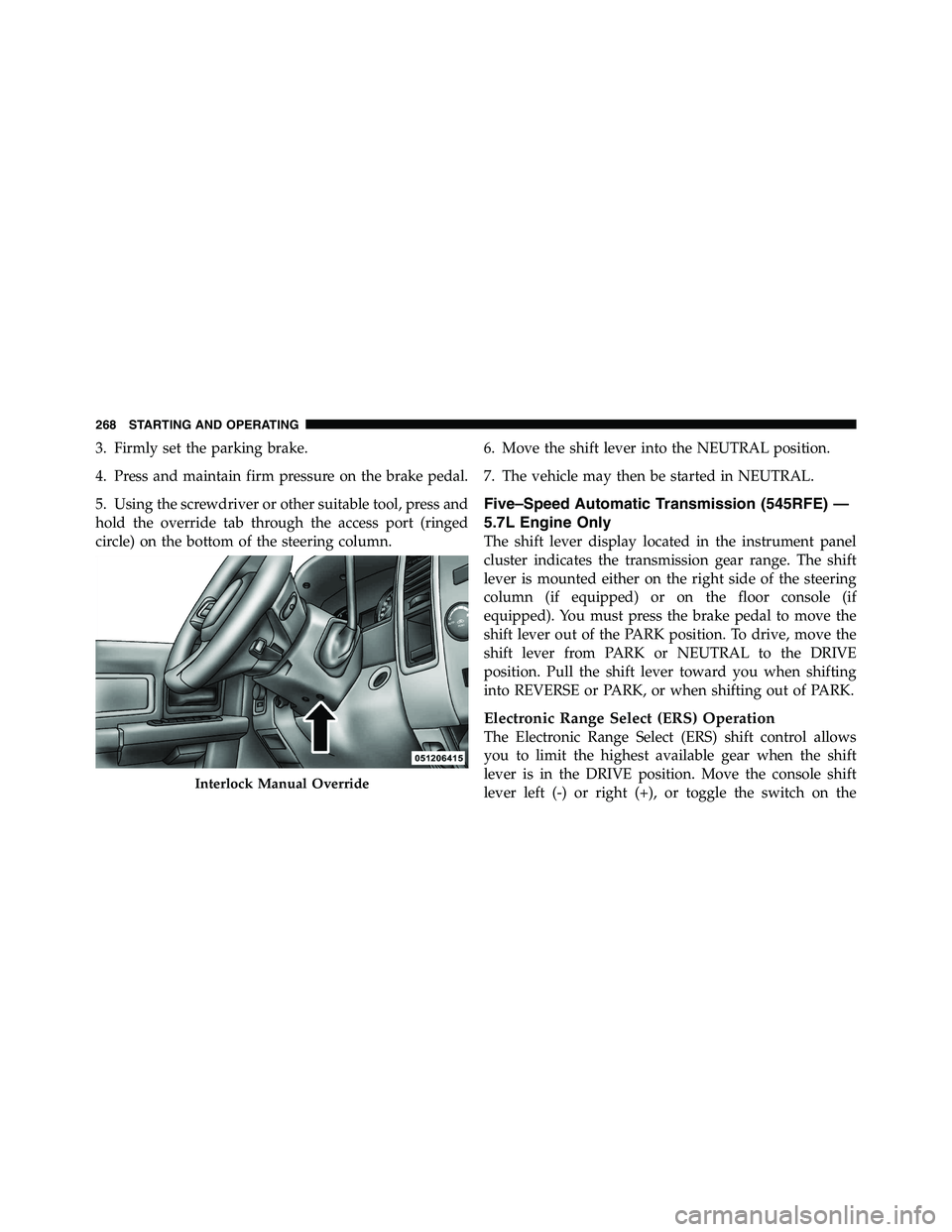
3. Firmly set the parking brake.
4. Press and maintain firm pressure on the brake pedal.
5. Using the screwdriver or other suitable tool, press and
hold the override tab through the access port (ringed
circle) on the bottom of the steering column. 6. Move the shift lever into the NEUTRAL position.
7. The vehicle may then be started in NEUTRAL.
Five–Speed Automatic Transmission (545RFE) —
5.7L Engine Only
The shift lever display located in the instrument panel
cluster indicates the transmission gear range. The shift
lever is mounted either on the right side of the steering
column (if equipped) or on the floor console (if
equipped). You must press the brake pedal to move the
shift lever out of the PARK position. To drive, move the
shift lever from PARK or NEUTRAL to the DRIVE
position. Pull the shift lever toward you when shifting
into REVERSE or PARK, or when shifting out of PARK.
Electronic Range Select (ERS) Operation
The Electronic Range Select (ERS) shift control allows
you to limit the highest available gear when the shift
lever is in the DRIVE position. Move the console shift
lever left (-) or right (+), or toggle the switch on theInterlock Manual Override268 STARTING AND OPERATING
Page 270 of 472
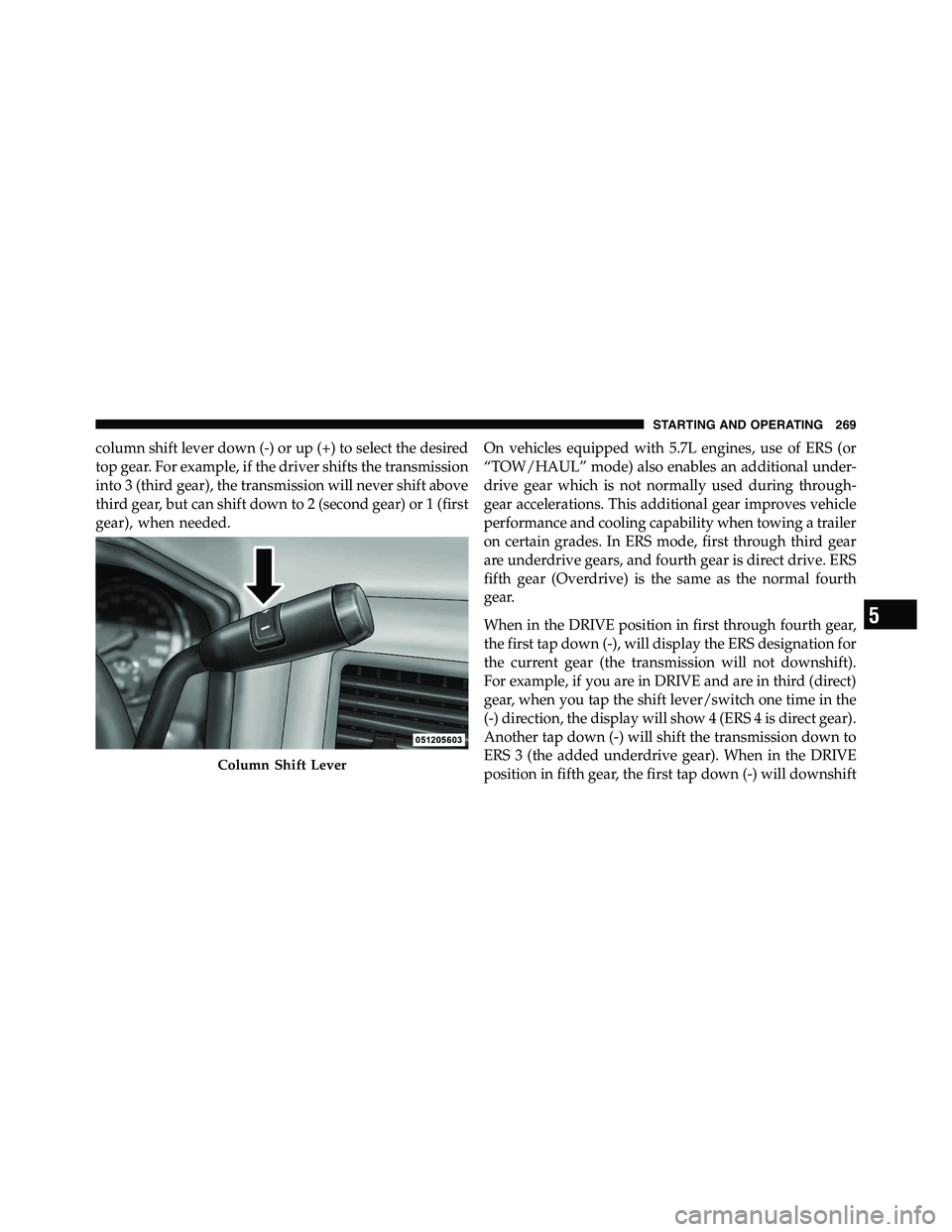
column shift lever down (-) or up (+) to select the desired
top gear. For example, if the driver shifts the transmission
into 3 (third gear), the transmission will never shift above
third gear, but can shift down to 2 (second gear) or 1 (first
gear), when needed. On vehicles equipped with 5.7L engines, use of ERS (or
“TOW/HAUL” mode) also enables an additional under-
drive gear which is not normally used during through-
gear accelerations. This additional gear improves vehicle
performance and cooling capability when towing a trailer
on certain grades. In ERS mode, first through third gear
are underdrive gears, and fourth gear is direct drive. ERS
fifth gear (Overdrive) is the same as the normal fourth
gear.
When in the DRIVE position in first through fourth gear,
the first tap down (-), will display the ERS designation for
the current gear (the transmission will not downshift).
For example, if you are in DRIVE and are in third (direct)
gear, when you tap the shift lever/switch one time in the
(-) direction, the display will show 4 (ERS 4 is direct gear).
Another tap down (-) will shift the transmission down to
ERS 3 (the added underdrive gear). When in the DRIVE
position in fifth gear, the first tap down (-) will downshiftColumn Shift Lever
5 STARTING AND OPERATING 269
Page 271 of 472
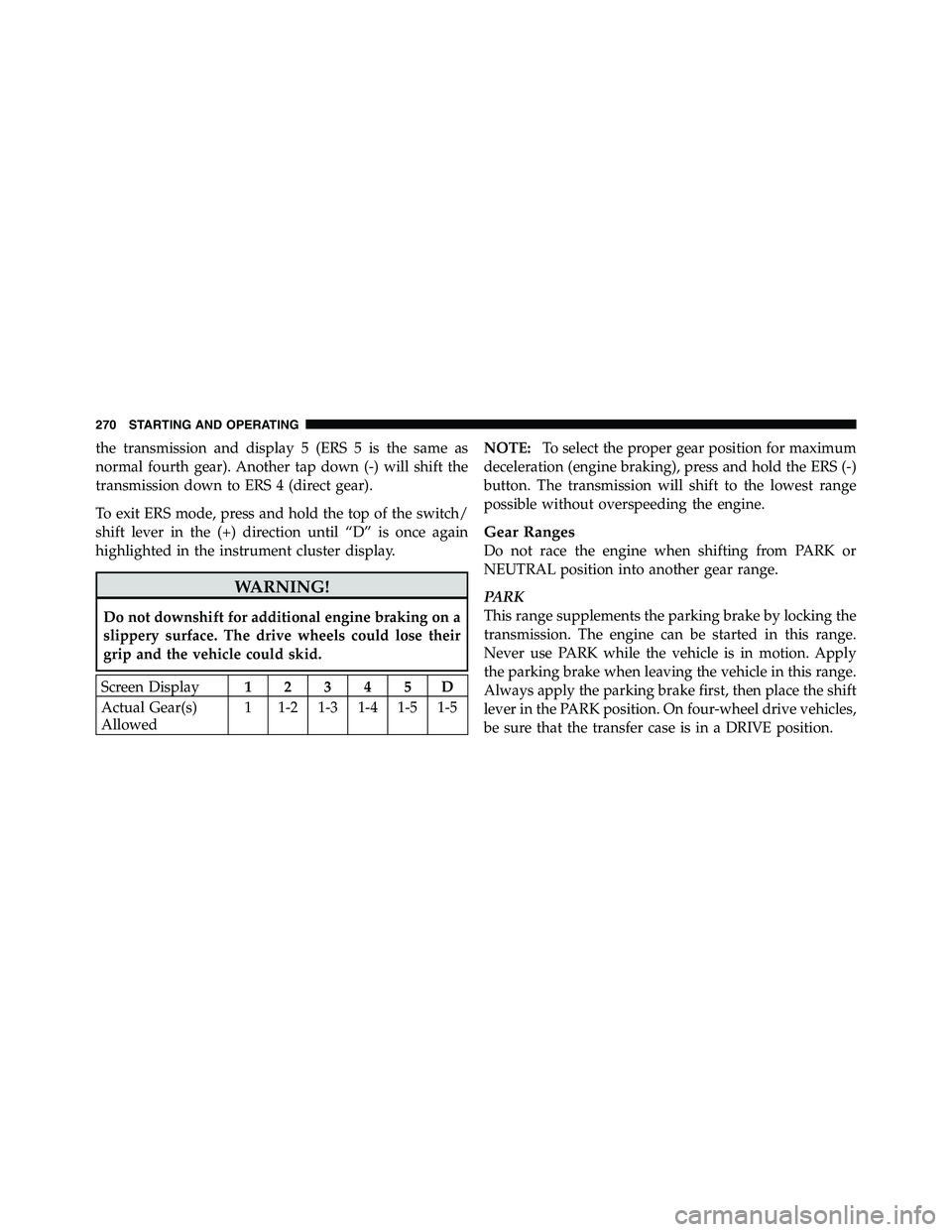
the transmission and display 5 (ERS 5 is the same as
normal fourth gear). Another tap down (-) will shift the
transmission down to ERS 4 (direct gear).
To exit ERS mode, press and hold the top of the switch/
shift lever in the (+) direction until “D” is once again
highlighted in the instrument cluster display.
WARNING!Do not downshift for additional engine braking on a
slippery surface. The drive wheels could lose their
grip and the vehicle could skid.
Screen Display 12345D
Actual Gear(s)
Allowed 1 1-2 1-3 1-4 1-5 1-5 NOTE: To select the proper gear position for maximum
deceleration (engine braking), press and hold the ERS (-)
button. The transmission will shift to the lowest range
possible without overspeeding the engine.
Gear Ranges
Do not race the engine when shifting from PARK or
NEUTRAL position into another gear range.
PARK
This range supplements the parking brake by locking the
transmission. The engine can be started in this range.
Never use PARK while the vehicle is in motion. Apply
the parking brake when leaving the vehicle in this range.
Always apply the parking brake first, then place the shift
lever in the PARK position. On four-wheel drive vehicles,
be sure that the transfer case is in a DRIVE position.270 STARTING AND OPERATING
Page 324 of 472
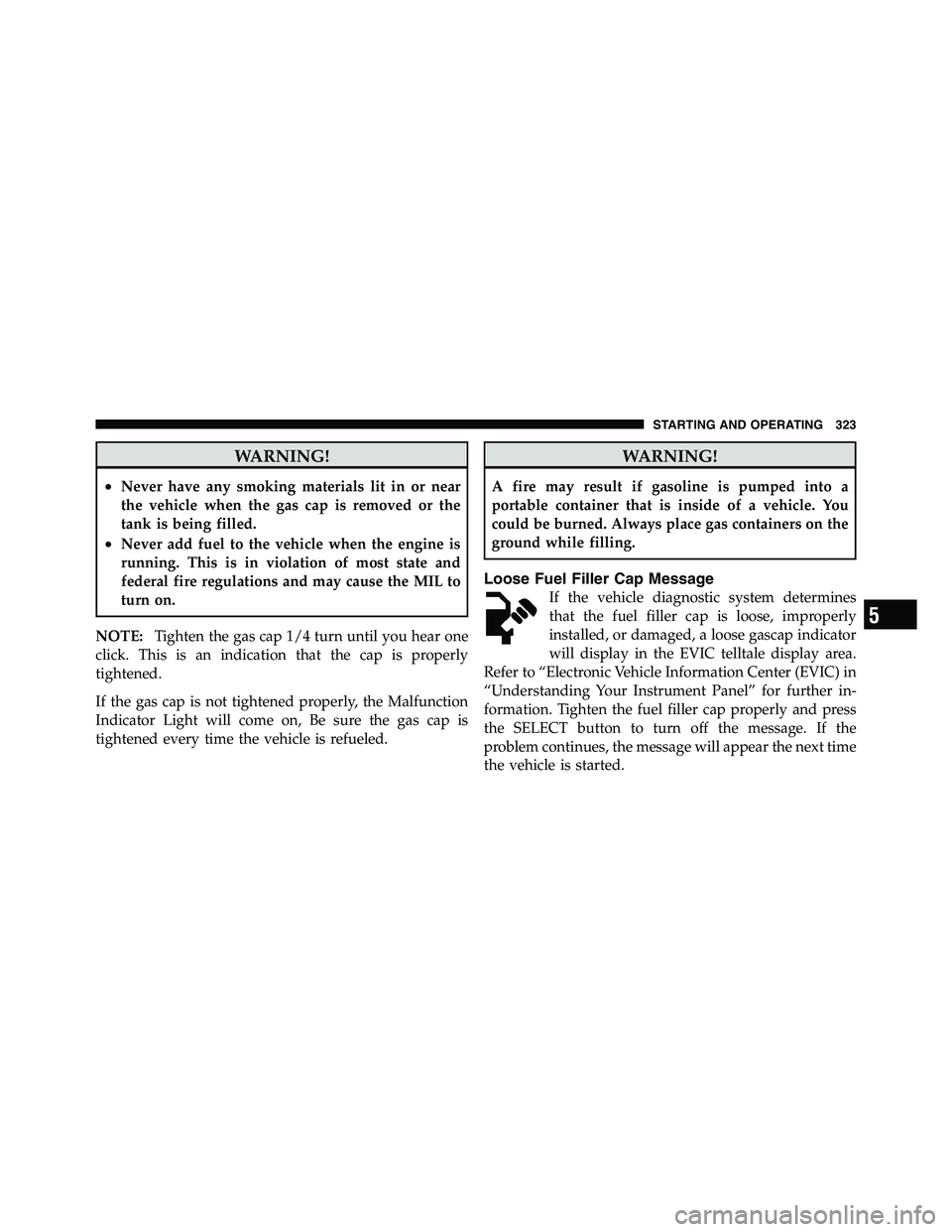
WARNING!• Never have any smoking materials lit in or near
the vehicle when the gas cap is removed or the
tank is being filled.
• Never add fuel to the vehicle when the engine is
running. This is in violation of most state and
federal fire regulations and may cause the MIL to
turn on.
NOTE: Tighten the gas cap 1/4 turn until you hear one
click. This is an indication that the cap is properly
tightened.
If the gas cap is not tightened properly, the Malfunction
Indicator Light will come on, Be sure the gas cap is
tightened every time the vehicle is refueled. WARNING!A fire may result if gasoline is pumped into a
portable container that is inside of a vehicle. You
could be burned. Always place gas containers on the
ground while filling.
Loose Fuel Filler Cap Message
If the vehicle diagnostic system determines
that the fuel filler cap is loose, improperly
installed, or damaged, a loose gascap indicator
will display in the EVIC telltale display area.
Refer to “Electronic Vehicle Information Center (EVIC) in
“Understanding Your Instrument Panel” for further in-
formation. Tighten the fuel filler cap properly and press
the SELECT button to turn off the message. If the
problem continues, the message will appear the next time
the vehicle is started.
5 STARTING AND OPERATING 323
Page 336 of 472
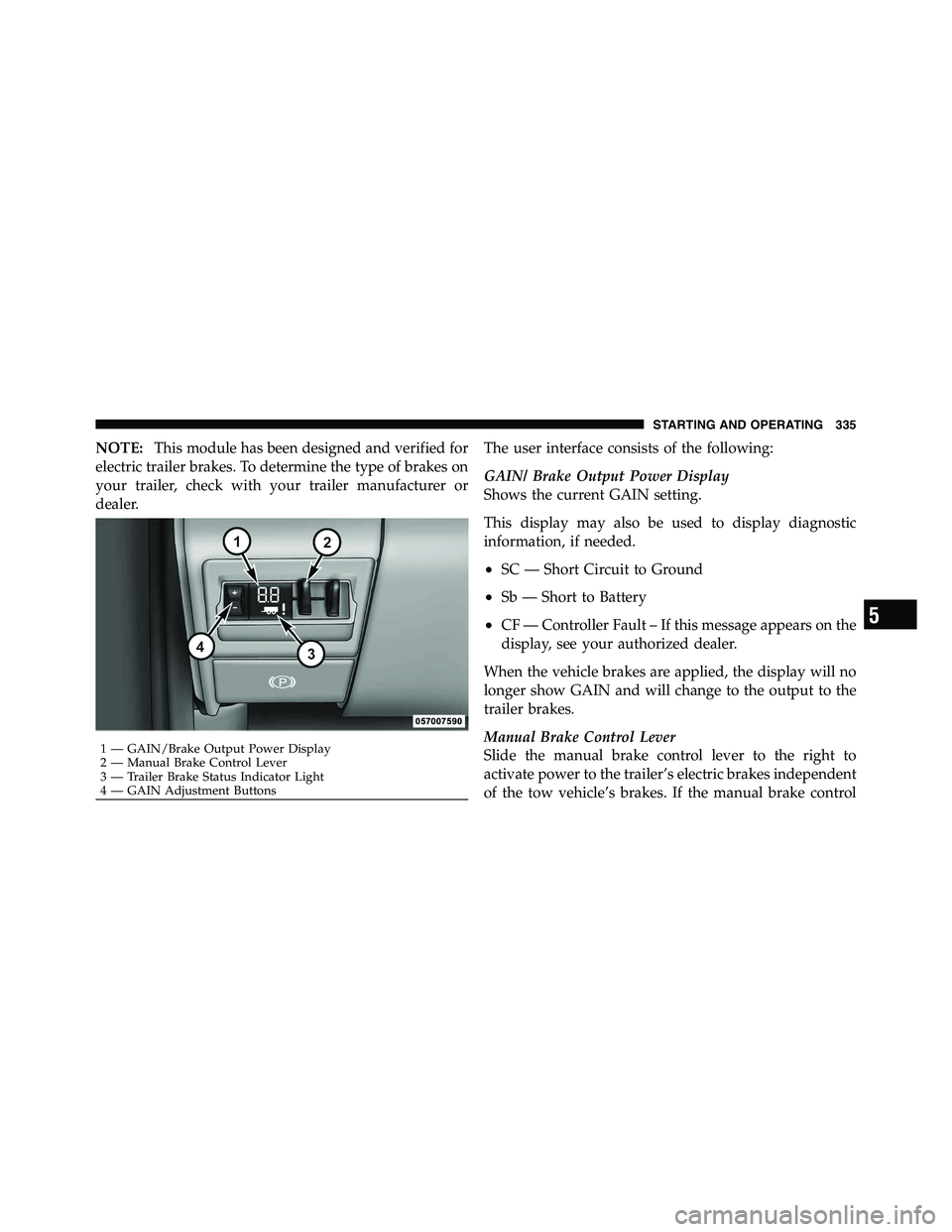
NOTE: This module has been designed and verified for
electric trailer brakes. To determine the type of brakes on
your trailer, check with your trailer manufacturer or
dealer. The user interface consists of the following:
GAIN/ Brake Output Power Display
Shows the current GAIN setting.
This display may also be used to display diagnostic
information, if needed.
• SC — Short Circuit to Ground
• Sb — Short to Battery
• CF — Controller Fault – If this message appears on the
display, see your authorized dealer.
When the vehicle brakes are applied, the display will no
longer show GAIN and will change to the output to the
trailer brakes.
Manual Brake Control Lever
Slide the manual brake control lever to the right to
activate power to the trailer’s electric brakes independent
of the tow vehicle’s brakes. If the manual brake control1 — GAIN/Brake Output Power Display
2 — Manual Brake Control Lever
3 — Trailer Brake Status Indicator Light
4 — GAIN Adjustment Buttons
5 STARTING AND OPERATING 335
Page 337 of 472
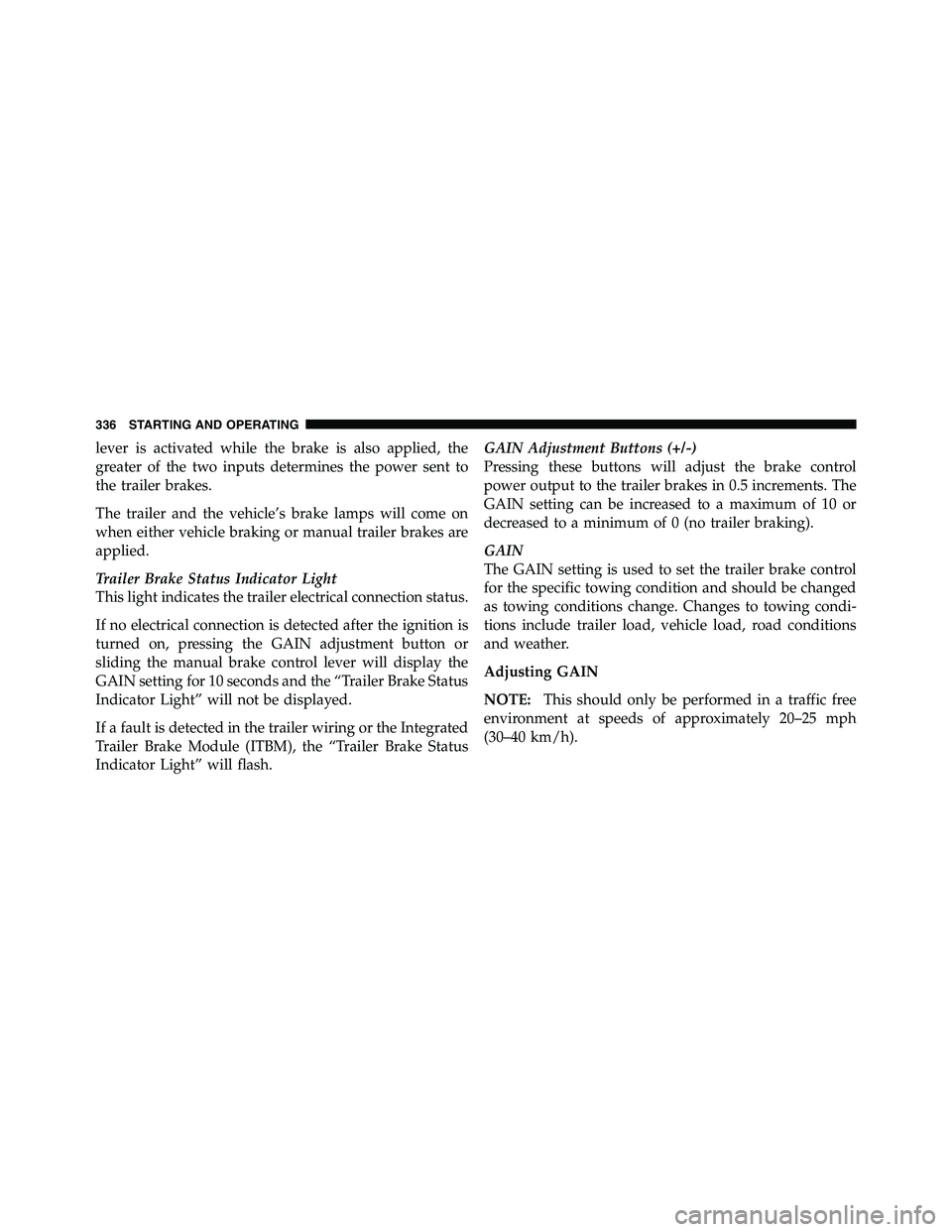
lever is activated while the brake is also applied, the
greater of the two inputs determines the power sent to
the trailer brakes.
The trailer and the vehicle’s brake lamps will come on
when either vehicle braking or manual trailer brakes are
applied.
Trailer Brake Status Indicator Light
This light indicates the trailer electrical connection status.
If no electrical connection is detected after the ignition is
turned on, pressing the GAIN adjustment button or
sliding the manual brake control lever will display the
GAIN setting for 10 seconds and the “Trailer Brake Status
Indicator Light” will not be displayed.
If a fault is detected in the trailer wiring or the Integrated
Trailer Brake Module (ITBM), the “Trailer Brake Status
Indicator Light” will flash. GAIN Adjustment Buttons (+/-)
Pressing these buttons will adjust the brake control
power output to the trailer brakes in 0.5 increments. The
GAIN setting can be increased to a maximum of 10 or
decreased to a minimum of 0 (no trailer braking).
GAIN
The GAIN setting is used to set the trailer brake control
for the specific towing condition and should be changed
as towing conditions change. Changes to towing condi-
tions include trailer load, vehicle load, road conditions
and weather.
Adjusting GAIN
NOTE: This should only be performed in a traffic free
environment at speeds of approximately 20–25 mph
(30–40 km/h).336 STARTING AND OPERATING
Page 338 of 472
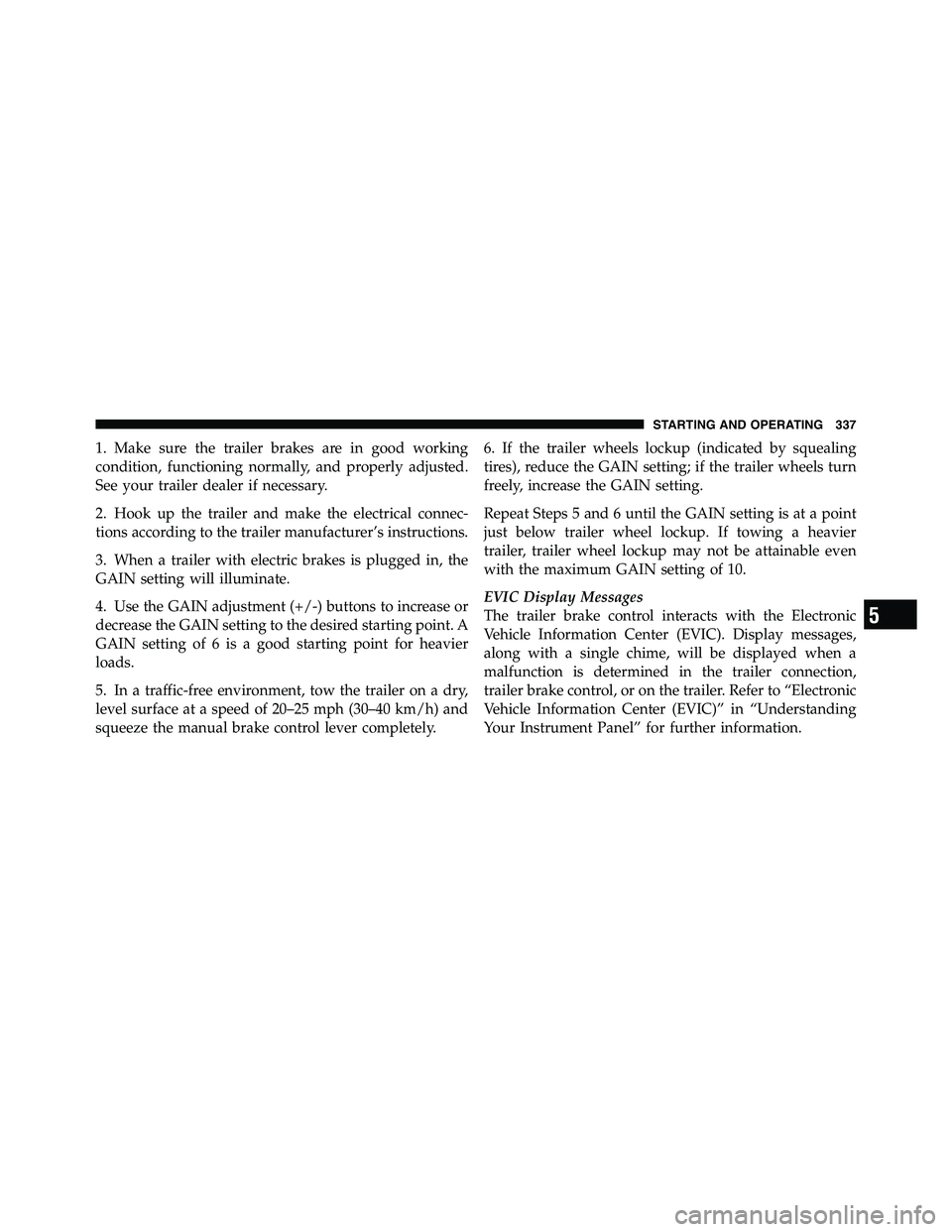
1. Make sure the trailer brakes are in good working
condition, functioning normally, and properly adjusted.
See your trailer dealer if necessary.
2. Hook up the trailer and make the electrical connec-
tions according to the trailer manufacturer’s instructions.
3. When a trailer with electric brakes is plugged in, the
GAIN setting will illuminate.
4. Use the GAIN adjustment (+/-) buttons to increase or
decrease the GAIN setting to the desired starting point. A
GAIN setting of 6 is a good starting point for heavier
loads.
5. In a traffic-free environment, tow the trailer on a dry,
level surface at a speed of 20–25 mph (30–40 km/h) and
squeeze the manual brake control lever completely. 6. If the trailer wheels lockup (indicated by squealing
tires), reduce the GAIN setting; if the trailer wheels turn
freely, increase the GAIN setting.
Repeat Steps 5 and 6 until the GAIN setting is at a point
just below trailer wheel lockup. If towing a heavier
trailer, trailer wheel lockup may not be attainable even
with the maximum GAIN setting of 10.
EVIC Display Messages
The trailer brake control interacts with the Electronic
Vehicle Information Center (EVIC). Display messages,
along with a single chime, will be displayed when a
malfunction is determined in the trailer connection,
trailer brake control, or on the trailer. Refer to “Electronic
Vehicle Information Center (EVIC)” in “Understanding
Your Instrument Panel” for further information.
5 STARTING AND OPERATING 337
Page 344 of 472
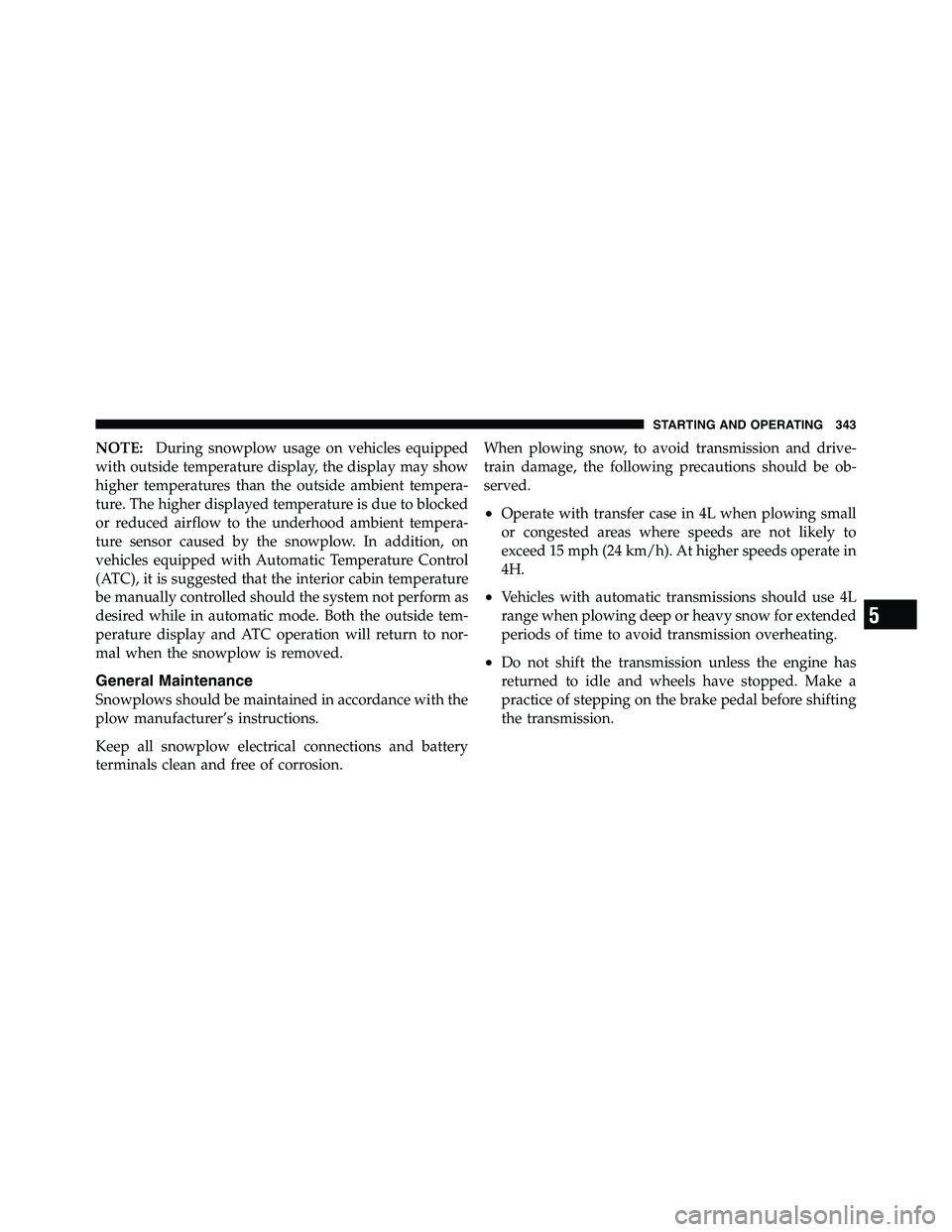
NOTE: During snowplow usage on vehicles equipped
with outside temperature display, the display may show
higher temperatures than the outside ambient tempera-
ture. The higher displayed temperature is due to blocked
or reduced airflow to the underhood ambient tempera-
ture sensor caused by the snowplow. In addition, on
vehicles equipped with Automatic Temperature Control
(ATC), it is suggested that the interior cabin temperature
be manually controlled should the system not perform as
desired while in automatic mode. Both the outside tem-
perature display and ATC operation will return to nor-
mal when the snowplow is removed.
General Maintenance
Snowplows should be maintained in accordance with the
plow manufacturer’s instructions.
Keep all snowplow electrical connections and battery
terminals clean and free of corrosion. When plowing snow, to avoid transmission and drive-
train damage, the following precautions should be ob-
served.
• Operate with transfer case in 4L when plowing small
or congested areas where speeds are not likely to
exceed 15 mph (24 km/h). At higher speeds operate in
4H.
• Vehicles with automatic transmissions should use 4L
range when plowing deep or heavy snow for extended
periods of time to avoid transmission overheating.
• Do not shift the transmission unless the engine has
returned to idle and wheels have stopped. Make a
practice of stepping on the brake pedal before shifting
the transmission.
5 STARTING AND OPERATING 343
Page 379 of 472
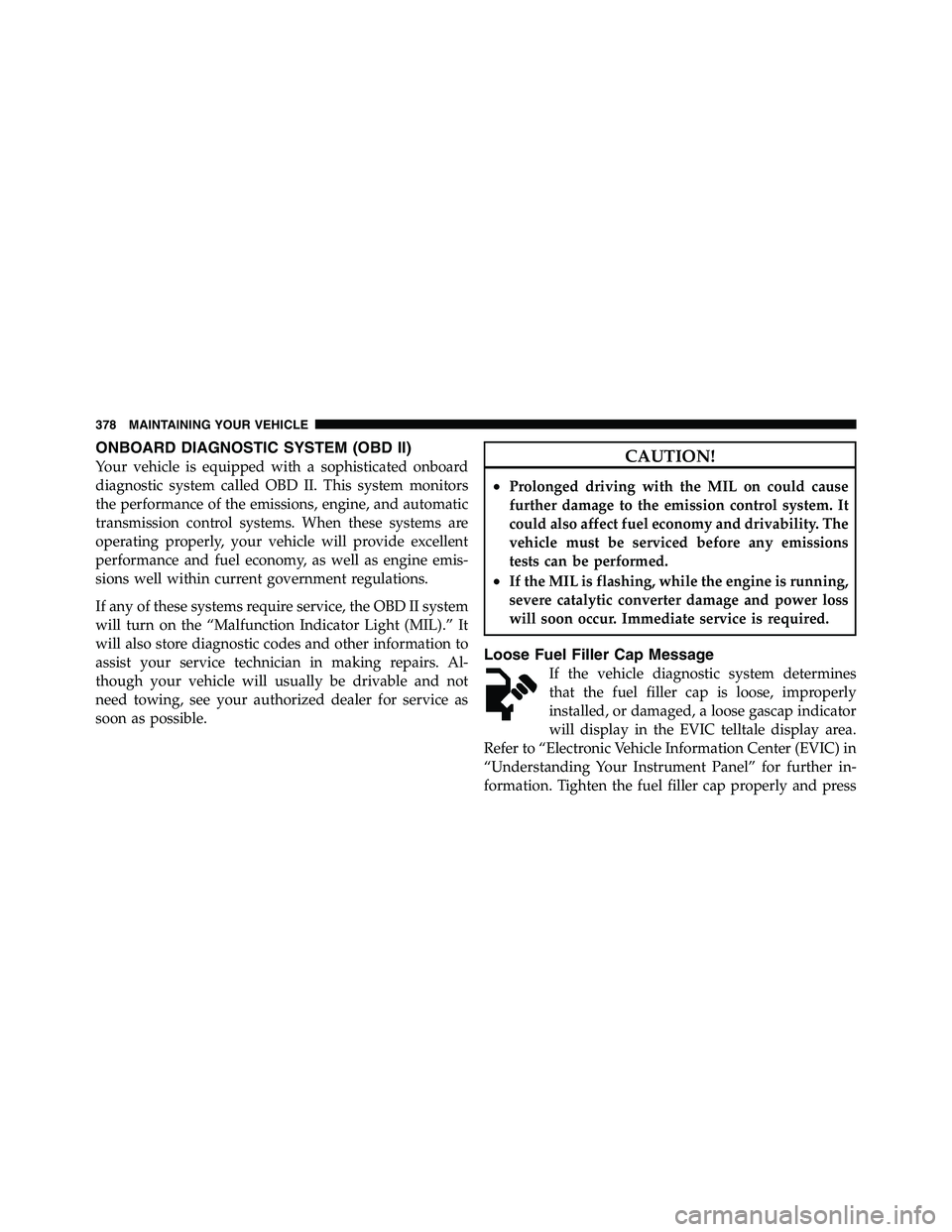
ONBOARD DIAGNOSTIC SYSTEM (OBD II)
Your vehicle is equipped with a sophisticated onboard
diagnostic system called OBD II. This system monitors
the performance of the emissions, engine, and automatic
transmission control systems. When these systems are
operating properly, your vehicle will provide excellent
performance and fuel economy, as well as engine emis-
sions well within current government regulations.
If any of these systems require service, the OBD II system
will turn on the “Malfunction Indicator Light (MIL).” It
will also store diagnostic codes and other information to
assist your service technician in making repairs. Al-
though your vehicle will usually be drivable and not
need towing, see your authorized dealer for service as
soon as possible. CAUTION!• Prolonged driving with the MIL on could cause
further damage to the emission control system. It
could also affect fuel economy and drivability. The
vehicle must be serviced before any emissions
tests can be performed.
• If the MIL is flashing, while the engine is running,
severe catalytic converter damage and power loss
will soon occur. Immediate service is required.
Loose Fuel Filler Cap Message
If the vehicle diagnostic system determines
that the fuel filler cap is loose, improperly
installed, or damaged, a loose gascap indicator
will display in the EVIC telltale display area.
Refer to “Electronic Vehicle Information Center (EVIC) in
“Understanding Your Instrument Panel” for further in-
formation. Tighten the fuel filler cap properly and press378 MAINTAINING YOUR VEHICLE
Page 427 of 472
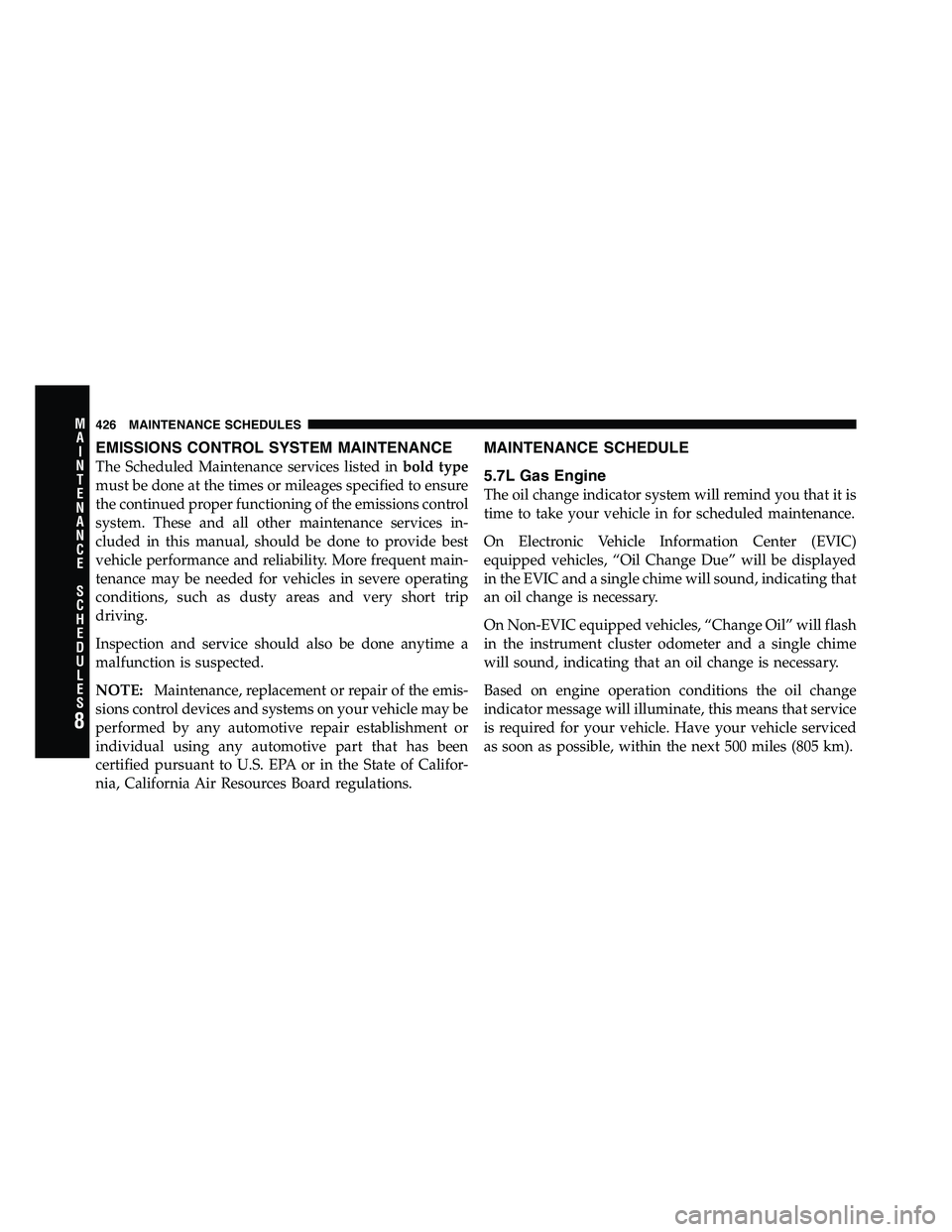
EMISSIONS CONTROL SYSTEM MAINTENANCE
The Scheduled Maintenance services listed in bold type
must be done at the times or mileages specified to ensure
the continued proper functioning of the emissions control
system. These and all other maintenance services in-
cluded in this manual, should be done to provide best
vehicle performance and reliability. More frequent main-
tenance may be needed for vehicles in severe operating
conditions, such as dusty areas and very short trip
driving.
Inspection and service should also be done anytime a
malfunction is suspected.
NOTE: Maintenance, replacement or repair of the emis-
sions control devices and systems on your vehicle may be
performed by any automotive repair establishment or
individual using any automotive part that has been
certified pursuant to U.S. EPA or in the State of Califor-
nia, California Air Resources Board regulations. MAINTENANCE SCHEDULE
5.7L Gas Engine
The oil change indicator system will remind you that it is
time to take your vehicle in for scheduled maintenance.
On Electronic Vehicle Information Center (EVIC)
equipped vehicles, “Oil Change Due” will be displayed
in the EVIC and a single chime will sound, indicating that
an oil change is necessary.
On Non-EVIC equipped vehicles, “Change Oil” will flash
in the instrument cluster odometer and a single chime
will sound, indicating that an oil change is necessary.
Based on engine operation conditions the oil change
indicator message will illuminate, this means that service
is required for your vehicle. Have your vehicle serviced
as soon as possible, within the next 500 miles (805 km).
8 M
A
I
N
T
E
N
A
N
C
E
S
C
H
E
D
U
L
E
S 426 MAINTENANCE SCHEDULES